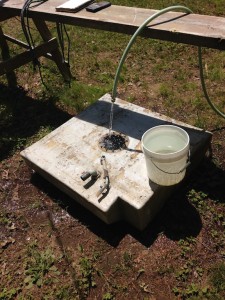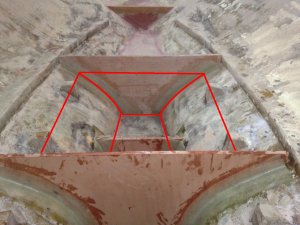6/8/14: Tank Discussion
Thalassa had two fiberglass freshwater tanks. (Click here to see a previous post that discussed these tanks.) Thalassa will need a holding (wastewater) tank and a freshwater tank. Three options were under consideration:
(1) Reuse the old tanks: Convert the forward tank into a holding tank and use the aft tank as the freshwater tank. The original tanks are in good condition.
(2) Build new, larger capacity, fiberglass tanks.
(3) Build integral tanks. Integral tanks, as we have discussed, use the hull as one or more sides of the tank.
To begin, the capacity of the two existing tanks were measured. A timer was used to measure the time required to fill a bucket with a garden hose. The 2.3-gal bucket in the photo below was filled in 25 seconds. Without disturbing the hose, the empty forward tank was moved and then filled with water from the hose. A time of 370 seconds was required to fill the tank. Thus, the capacity of the forward tank is (370 sec)(2.3 gal/25 sec) = 34 gal. The bucket was filled again, as a check. Once again, 25 seconds was require to fill the bucket. Using the same method, the aft tank was found to have a capacity of 55 gal.
Capacities of 34 and 55 gal are pretty good. Constructing new tanks would be time consuming and expensive, so option (2) was eliminated. What about integral tanks? The red lines in the photo below show the outline of a possible integral holding tank. As we can see, the forward and aft sides of this tank would be bulkheads, and the bottom and sides would be keel and hull, respectively. A top would be constructed, as well as internal baffles that reduce sloshing of the contents, which significantly reduces the potential forces on the sides and top.
Integral fiberglass tanks have been built since the advent of fiberglass, but there is little information about them on the internet. Many reputable yacht builders use integral tanks, however, so they are worthy of consideration.
There are two common arguments against integral tanks:
(1) Hulls flex, which may cause failure of an integral tank. Many Beneteau yachts have integral water tanks, and several incidents of failure can be found on the internet. Beneteau yachts, however, are thin-skinned racer/cruisers. Thalassa, on the other hand, is heavily built, and there is little concern about flexing in the bilge area, especially with three or more athwartship baffles serving as additional bulkhead-like strengthening.
(2) The contents of an integral tank may, through osmosis, penetrate the laminates that form the hull. Osmotic blistering is the result of the same concern, but originating from outside the hull. Hulls, however, are laminated with polyester resin. Epoxy resin is much less permeable by liquids. Additional layers of glass along the hull and keel, and a buildup of layers of epoxy would largely alleviate this concern.
There are three common arguments for integral tanks:
(1) Integral tanks utilize space most effectively. In Thalassa, a 50-60 gal holding tank and a 90-100 gal freshwater tank would be constructed. More capacity is likely possible, but the additional weight would be a concern.
(2) The tank and internal baffles form structure that makes the boat stronger and stiffer.
(3) In the unfortunate event that the hull is holed in the location of an integral tank, no seawater would enter the boat.

